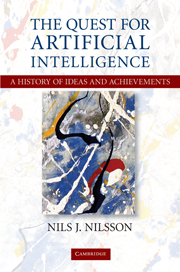Book contents
- Frontmatter
- Contents
- Preface
- PART I BEGINNINGS
- PART II EARLY EXPLORATIONS: 1950S AND 1960S
- 3 Gatherings
- 4 Pattern Recognition
- 5 Early Heuristic Programs
- 6 Semantic Representations
- 7 Natural Language Processing
- 8 1960s' Infrastructure
- PART III EFFLORESCENCE: MID-1960S TO MID-1970S
- PART IV APPLICATIONS AND SPECIALIZATIONS: 1970s TO EARLY 1980s
- PART V “NEW-GENERATION” PROJECT
- PART VI ENTR'ACTE
- PART VII THE GROWING ARMAMENTARIUM: FROM THE 1980s ONWARD
- PART VIII MODERN AI: TODAY AND TOMORROW
- Index
- Plate section
3 - Gatherings
Published online by Cambridge University Press: 05 August 2013
- Frontmatter
- Contents
- Preface
- PART I BEGINNINGS
- PART II EARLY EXPLORATIONS: 1950S AND 1960S
- 3 Gatherings
- 4 Pattern Recognition
- 5 Early Heuristic Programs
- 6 Semantic Representations
- 7 Natural Language Processing
- 8 1960s' Infrastructure
- PART III EFFLORESCENCE: MID-1960S TO MID-1970S
- PART IV APPLICATIONS AND SPECIALIZATIONS: 1970s TO EARLY 1980s
- PART V “NEW-GENERATION” PROJECT
- PART VI ENTR'ACTE
- PART VII THE GROWING ARMAMENTARIUM: FROM THE 1980s ONWARD
- PART VIII MODERN AI: TODAY AND TOMORROW
- Index
- Plate section
Summary
In september 1948, an interdisciplinary conference was held at the California Institute of Technology (Caltech) in Pasadena, California, on the topics of how the nervous system controls behavior and how the brain might be compared to a computer. It was called the Hixon Symposium on Cerebral Mechanisms in Behavior. Several luminaries attended and gave papers, among them Warren McCulloch, John von Neumann, and Karl Lashley (1890–1958), a prominent psychologist. Lashley gave what some thought was the most important talk at the symposium. He faulted behaviorism for its static view of brain function and claimed that to explain human abilities for planning and language, psychologists would have to begin considering dynamic, hierarchical structures. Lashley's talk laid out the foundations for what would become cognitive science.
The emergence of artificial intelligence as a full-fledged field of research coincided with (and was launched by) three important meetings – one in 1955, one in 1956, and one in 1958. In 1955, a “Session on Learning Machines” was held in conjunction with the 1955 Western Joint Computer Conference in Los Angeles. In 1956, a “Summer Research Project on Artificial Intelligence” was convened at Dartmouth College. And in 1958, a symposium on the “Mechanization of Thought Processes,” was sponsored by the National Physical Laboratory in the United Kingdom.
- Type
- Chapter
- Information
- The Quest for Artificial Intelligence , pp. 49 - 61Publisher: Cambridge University PressPrint publication year: 2009



